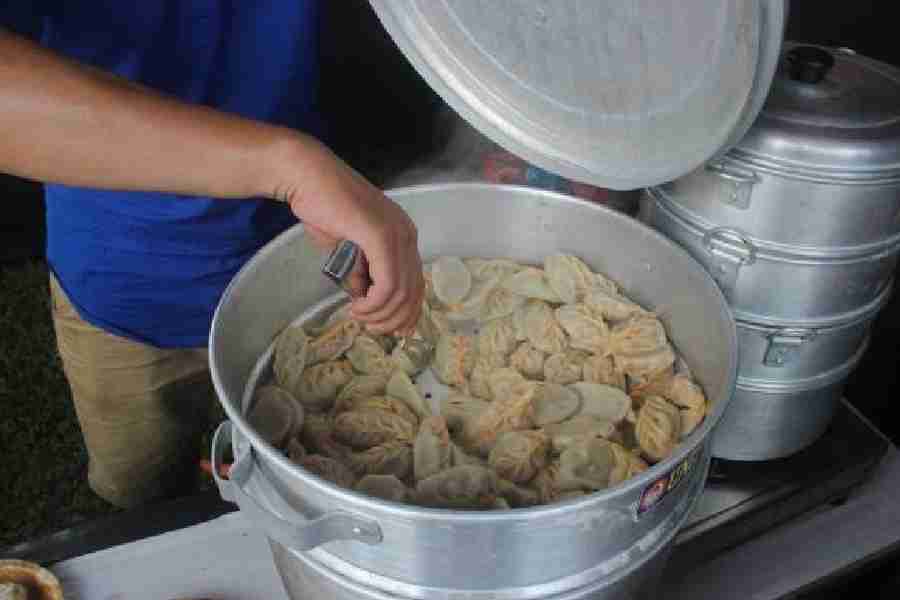Did you know it was Satyajit Ray who brought momos to Calcutta, asked a friend the other day. He continued, “Ray was so fond of them that he requested someone from north Bengal to move to our city and open a shop here.” I have found nothing so far to corroborate this claim, but there’s no doubt it is Ray who introduced me to the succulent, savoury dumplings.
I never met Ray, nor even saw him from afar. Having grown up in a steel township which was once part of Bihar, my familiarity with him was entirely through his stories in the Puja special editions of Anandamela, Desh and his Feluda series. It was in the story about the sleuth’s adventures in Nepal, titled Joto Kando Kathmandute, that I tasted my first momo — in theory — along with Feluda’s friend and writer Lalmohanbabu.
However, the first momo that I actually ate was in mid-1990s Calcutta and it was nothing like the dish I had in mind. A family friend, married to a Nepali from Darjeeling, had made the dumplings, soup and all. With a taste for the bland, I quite liked what was served. Feluda’s addendum that momos originated in Tibet is not wrong. But momos are also the national dish of Nepal.
In Ray’s Joto Kando Kathmandute, the waiter at the restaurant had told Lalmohanbabu, “It’s meatballs in sauce.” Given my (little) exposure to Russian cuisine early on in life — Bokaro Steel Plant was built in collaboration with Russians and we had had the opportunity of hosting each other a few times — I had imagined that momos would be something like tefteli, which is meatballs fried, steamed or braised, in sauce, somewhat resembling the Bengali kofta curry.
It’s truly confounding why I hadn’t eaten momos earlier, considering I had arrived in Calcutta just a few years after Ray’s story was first published in 1980. Maybe I had forgotten momos by the time I landed here. Maybe the restrictions of a girls’ hostel in those times left little scope to explore the city. Maybe because I didn’t go looking all that doggedly for new food to suit my palate.
Momos had a growing fan base in Calcutta by the end of the 1980s. Some believe that the Bhutanese who come to the city every winter to sell woollens brought the momo with them. But the first eatery in Calcutta to sell momos professionally was Hamro Momo, which was on Suburban Hospital Road. The proprietors had picked up the skills and recipes from a Tibetan woman.
The elderly Tibetan couple had moved to Calcutta after spending many decades in north Bengal’s Kalimpong. The wife made momos and other Tibetan dishes, mostly pork-based. She prepared the food at home; her customer base was the people in the neighbourhood. Soon, other eateries serving Tibe- tan delights came up in that lane. And, in the early 1990s, Suburban Hospital Road earned the moniker “Momo Gully”.
With the boom in the food industry a few years on came more cuisines and confusion. Chinese. Nepalese. Tibetan. When it comes to food, to date, these labels are used by most people interchangeably. Momos, dimsums, dumplings, wontons to many are different names for the same thing. In 2017, a BJP leader took up cudgels against “Chinese street food” and included in his list of pet hates the momo.
In the 1928 book The People of Tibet, Sir Charles Bell — British India’s ambassador to Tibet — writes that a Tibetan gentleman usually has certain set options for lunch and one of these is “ten or fifteen small meat dumplings (mo-mo)”. Since those times, the momo has been incarnated many a time and into many an avatar. Today, in this city, it enjoys pride of place as a roadside delicacy alongside rolls and chowmein. There is the pork momo, the chicken momo, and the veg momo, which is not a personal favourite. There’s just so much blandness I can take!
In all of this chaos, the traditional liquid accompaniment to the momo, the soup, has gone missing. Recently, someone commented on social media that the red chutney and mayonnaise that often accompany momos in Calcutta are very “Delhi style” and wondered aloud if the future of the momo would be “tandoori, Afghani or Schezwan”.
A cousin, who had tasted momos for the first time in Manipur in the early 1990s, feels that be it a roadside stall or a high-end eatery, what he has tasted here is an apology for the momo soup. And the debate continues.
But to get back to the point I started out with. Momo Gully is a stone’s throw from Bishop Lefroy Road, Ray’s address for the last two decades of his life. Those were apparently the years when he was at his creative best.
Something to do with the momos perhaps?











